The view was tantalizing.
We were finally in a shuttle boat gliding gently up the creek between two sheer walls of stone country that rose either side to touch the sky, framing the distant escarpment and our destination Gungkurdul (Twin Falls).
Peering down this narrow chasm was like looking into a lost world – ancient and untouched.
It felt as though we were in the very heart of Kakadu (so named from a European interpretation of a local Aboriginal floodplain language – Gagudju)
Access to Twin Falls
To get here, to the entrance into Twin Falls, we’d driven:
- 300 km (185miles) on a bitumen road south east from Darwin (via Jabiru/Bowali Visitor Centre, which is 50km (30miles) from the Jim Jim road turnoff, and for reference 6 km (4miles) east of the Cooinda/Yellow Water turn off).
- 60km (37miles) off the main Kakadu Hwy heading south on the Jim Jim (no through) Road
We’d then been bumped and jiggled and twisted down the single 4WD dirt track driving across the top end Savannah bush…
- 20km (12miles) on a 4WD single track dirt road
- Crossed Jim Jim Creek at a deep water river crossing (vehicle snorkel recommended)
- Walked up a sandy path to the Twin Falls creek, then
- A 15 minute boat ride up the creek
Kakadu National Park – Twin Falls boat shuttle service
- Another walk along a narrow, sheer sided rocky path
- Followed by a floating metal boardwalk, with hand pump operated shower heads to cool off (as no swimming is permitted at Twin Falls)
Despite our intrusion, there’s an untamed wildness here –
And for 6 months of the year it is totally wild –
Between December and May torrents of wet season flood waters cascade down from the plateau above, leaving Twin Falls free to rumbustiously wash away man’s marks left from the dry season invasion.
Preparing Twin Falls for our Visit by the Kakadu Park Rangers
Parks and Wildlife do an amazing pre-season job each year to prepare this area of the World Heritage Kakadu National Park so visitors to the region who yearn to see this treasure can gain access.
The behind the scenes work done by the Kakadu Rangers has been documented in a one year project to film and record a year in the life of Kakadu broadcast on ABC (Australian Broadcasting Corporation).
I can highly recommend watching, if you get the opportunity – Here is a trailer.
The Park Rangers have only weeks after the waters start to recede at the end of the wet season, and the creeks lower sufficiently to gain access, to get their critical work underway checking for salt water crocodiles that infiltrate the area via the waterlogged floodplains.
Crocodile traps are flown in by helicopter and baited, while ground and aerial surveys are carried out to hunt down and remove any crocodiles in the near vicinity that could cause a threat to tourists.
However, as a precaution there’s still no swimming allowed at Twin Falls, and when we were there the crocodile trap was still in place at the bottom of the beach.
The metal boardwalks are then flown in by helicopter, in sections, before any visitors can get up to the Falls . (They’re dismantled and flown back out at the end of the season to avoid damage by the rampaging river that flows down the gorge during the wet season)
Twin Falls – Gungkurdul
The floating pontoon to Twin Falls is the final stepping stone to the white sandy beach that leads up to the Falls at the very end of the gorge.
A monumental sandstone escarpment encircles the waterhole that lies at the base of the falls, flanked by a white sandy beach –
It’s an ancient landscape that has remained unchanged for eons – other than the one metre height that’s eroded away every 100,000 years!
Over the dry season months June – October, we’re lucky enough to access and experience this stunning location.
But, the forces of nature dictates when the season will end as the temperature and humidity rises and the cloud formations build up ready to deluge the country once again during the Wet Season November – May.
The power of the Northern Territory is its mystery –
Unlike most places that can be trampled over on demand, the Territory keeps much of its magic under wraps, only allowing glimpses of her many tucked away precious places that we’re privy to enjoy.
Twin Falls – A piece of paradise.
“People need to come here and relax,
sit on the country,
feel the spirits of this country,
and go home and feel the same way.”
Natasha Nadji
Bunidj Clan
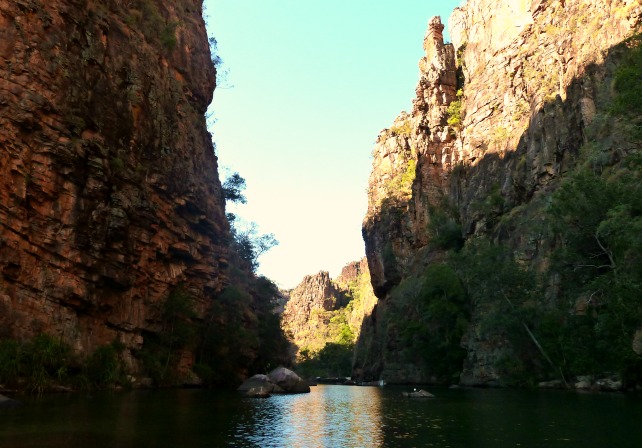
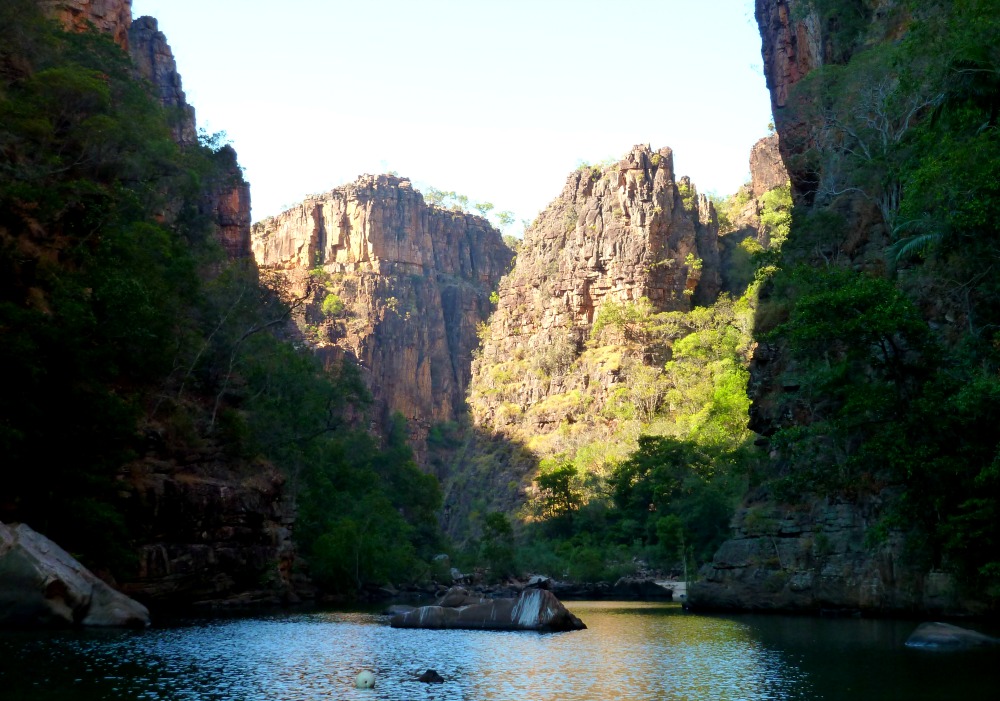

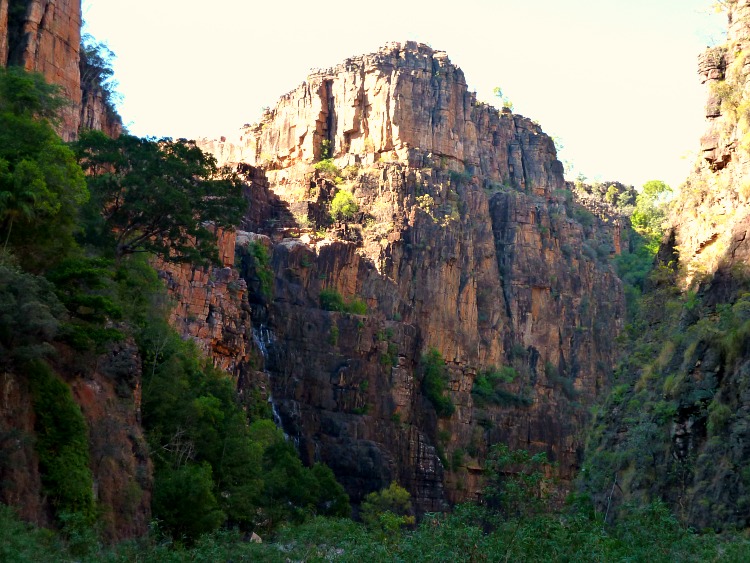
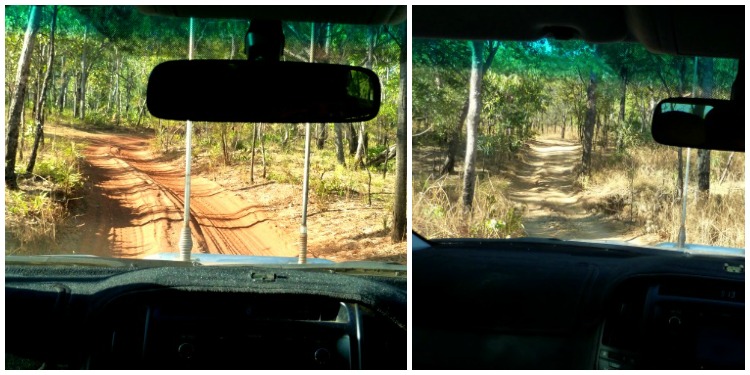
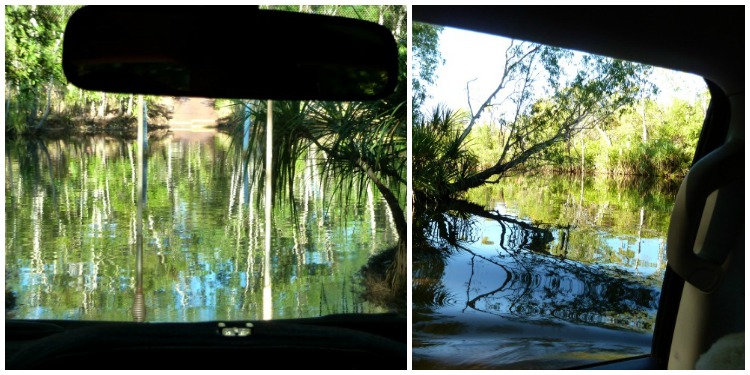

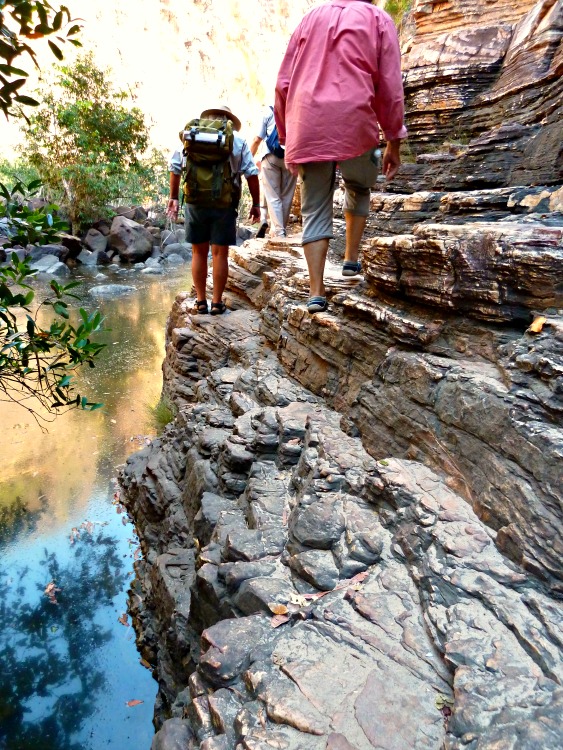
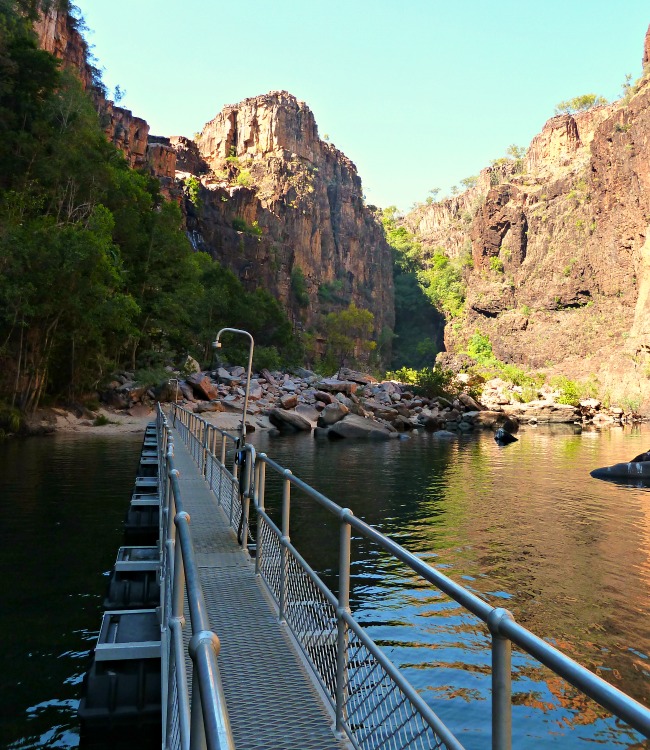



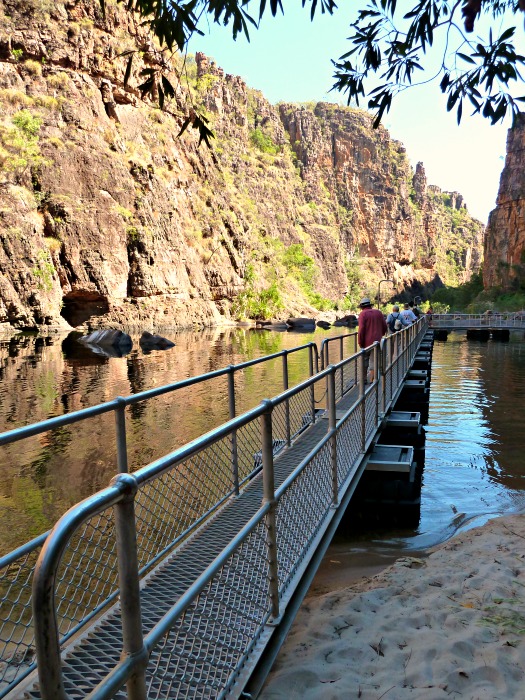





A great informative post, what a spectacular place it is 😉
I’d waited years to get there!
And it didn’t disappoint 🙂
Thanks for sharing Linda! BTW what camera are you using? Great photos!
Thanks for dropping by 🙂
I use a little Lumix with a Leica lens point and shoot camera – Nothing fancy – and more importantly easy to carry and keep in a pocket so its always on hand!
A great post covering part of a unique environment that should be on everyone’s bucket list.
The post brought back memories of our experience in Kakadu some years back.
We spent a week in Kakadu in 1985 and visited Twin Falls and Jim Jim Falls. We were on our 20 week round Oz before having kids trip.
My wife and I were travelling with another couple. We were all in our mid-20s and pretty care free at the time.
Prior to reaching Kakadu we visited Darwin for a week and prepared for our visit to the falls. We had heard that a crocodile was living at the base of the falls. In those days there was no boat to take you up the gorge. Out plan was to make a raft from truck tyre tubes and paddle up the gorge to the falls. We scrounged 4 old truck tyre tubes in Darwin and patched the holes.
When we got to Twin Falls we pumped up the tyre tubes and tied them together into a rudimentary raft. As we were readying our raft to paddle up the gorge some other people arrived back from the falls in their kayak. They said the crocodile was under the falls and that it should be pretty safe to paddle the gorge on our raft.
We were still a little apprehensive but decided we would take a chance and we started paddling our tyre tube raft along the gorge towards the falls. After a couple of hundred metres three of the tyre tubes started to deflate leaving just my tyre tube inflated.
We paddled a further hundred metres and the three tyre tubes that my wife and the other couple were on were now nearly completely deflated and they had to swim in the freezing cold water of the gorge.
I remained on the last inflated tyre tube and remember paddling along gazing into the crystal clear water wondering if the crocodile had followed the kayak back towards where we were. As I was concentrating on peering into the water, our male friend swam under my tyre tube and came out of the water with a roar, right in front of me. That frightened ten years growth out of me and I fell off the tyre tube to a great deal of echoing laughter from my wife and friends. We swam the remainder of the gorge to the falls keeping a vigilant look out for the crocodile.
We arrived at a rocky and sandy outcrop 50 to 100 metres from the falls and were relieved to see the crocodile sunning itself near the base of the falls. I don’t recall whether it was a salty or fresh water croc.
We spent some time exploring the falls area before swimming back to our vehicles with the deflated tyre tube raft in tow.
That was quite a memorable experience from our trip, as you could imagine.
What a wonderful story Allan –
I guess looking on the positive side – The fact crocs only became protected in the early 70’s hopefully would mean the croc you saw (even if it was a salty) would have been a “youngster’ compared to the monsters that could now be in the gorge 40 years on!
Love that story – and a great reminder of the fact the shuttle boat has been there for so few years –
Thanks so much for sharing 🙂
Glad you liked the story Linda.
The croc we saw certainly wasn’t a monster like we see around today. No doubt the croc would have been a teenager and was born after the croc protection measures were implemented.
We often hear complaint about improved infrastructure in national parks that impinge on the natural environment and restrict where we can set up camp and the like. A positive side to improved infrastructure is that more people gain access to these areas.
My wife and I plan on heading back to Kakadu in a few years and I’m sure that we will appreciate the shuttle boat and easier accessibility up the gorge to the falls.
Today, without the ferry no one would be able to access Twin Falls, as no one in their right mind would even contemplate running the gauntlet to swim in any Top End creek!
The ferry and the pontoon walkway (with their brilliant hand pumped showers to cool off on the inevitable stinking hot Top End days) in no way takes away from the adventure or impinges upon the natural environment as you still have to clamber over rocks and balance along narrow edged paths!
We stayed at the Merl National Park campground near Ubirr and I have to say I was impressed that they didn’t squash you in like sardines (which is so ludicrous when you’re surrounded by the vastness of the outback) but they’d created individual camping spots set in among the trees so you actually felt you were in the bush!
Beautiful photos and a fascinating place!
Thank you Jan 🙂
Great post with lots of good information and great photos as well!
Thanks for dropping by Cacinda – And the compliments! 🙂
What stunning photos. Places I never heard of that made it on my wish list.
Its hard to take a bad photo of this region Billie 🙂
Twin Falls takes a bit of getting to… but makes the reward of seeing it in the flesh all the sweeter!
So far we haven’t ventured far away from the coasts (east, west and south) on either of our trips to Oz. I can appreciate the not wanting to “Swim with the Crocs” sentiment, but those rock ledge “paths” also looked pretty dodgy to me. The only wilderness hiking we’ve done was on the Milford Track on the South Island of New Zealand. The beauty of that hike (besides the actual beauty of the scenery) is that none of the wildlife wants to eat you. A kea (alpine parrot) might want to steal your lunch bag, but would not be interested in actually having you for lunch.
I went to NZ when my two boys were quite small, and I have to say – It was a huge relief (what with the propensity young boys have to explore under stones) that we were in a country with NO snakes and only one venomous spider that inhabits the Nelson region!
Yes, the path into Twin Falls can be a little challenging but certainly not insurmountable –
Unlike the final section to the swimming hole at nearby Jim Jim Falls where the “path” has you clambering over massive tumbled rocks… which at least keeps the crocs at bay 😉
Wow! That looks like an exciting walk~
Your great photography took us there with you.
Thanks Irene ~
Kakadu and the Territory are such a wonderful experience 😉
What a wonderful and interesting trip Linda. We take so much for granted in Australia, and I’m constantly in awe of the various Parks and Wildlife boards, and rangers, that make walking and travelling such a fabulous experience for us. Flying in the boardwalks by helicopter each season – amazing! Putting down croc bait – thoughtful! Even the welcome shower on the bridge to cool off under – now who’d have thought of that! It looks like a trip we’d love to do, and the hiking and scenery look awesome. Love, love, love the quote at the end penned in one of your jottings journals.
Thanks so much Jo!
Kakadu is a wonderful National Park but due to its size (one third the size of Tasmania) of which 80% is endless savannah country, I feel the timelessness of the landscape demands you slow down and join it in order to “…feel the spirits of this country…”
But when you do… Its magic 🙂
Linda, thanks for sharing your visit to Twin Falls. It sounds like you definitely got some good value out of your prize money!!
I have previously visited Kakadu at the end of the wet season and we were able to visit Ubirr and we did a flight over Jim Jim Falls which were in full flood! I would love to visit again one day during the dry season and do this trek as you have described!
I have also enjoyed watching the new Kakadu series – they have done a great job of explaining how the park works and what they have to do to protect it for the future.
I’m envious of your flight over the Falls in the Wet season –
Having watched the numerous photographic shots of that on the Kakadu series I need to now go back to see it in full flood from the air – like you have!
Yes – It was a brilliant trip – By camping to keep accommodation costs down to a minimum we were able to make the most of fun trips such as this – that also went to Jim Jim Falls – and which I’ll write about in another post 🙂